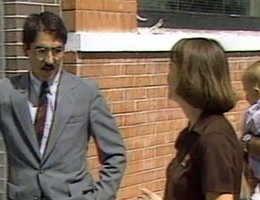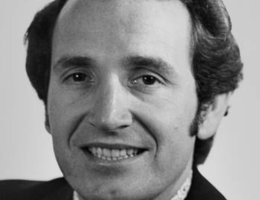

The resentment that many farmers felt against bankers reached the boiling point during the height of the farm crisis in the 1980s. Some bankers said they got the silent treatment on the street. A few were even assaulted by angry customers. Some farmers wore black armbands to protest foreclosures. Bankers became the target of bitter jokes making the rounds in Nebraska communities.
Question: What’s the difference between a dead skunk on the road and a dead loan officer?
Answer: There are skid marks in front of the skunk.
Naturally, that kind of talk offended the bankers, many of whom lived in the community and grew up with the farmers making the jokes.
Did bankers contribute to the farm crisis of the 1980s, or were they victims of the crisis just as the Nebraska farmers were victims? Did farmers, bankers, and the federal government all play the role of the villain? Those are complex questions and there are many viewpoints.
David Stockman, President Reagan’s Budget Director, was quoted in 1985 as saying,
"For the life of me, I cannot figure out why the taxpayers of this country have the responsibility to go in and refinance bad debt that was willingly incurred by consenting adults who went out and bought farmland when the price was going up and thought that they could get rich."


Iowa Senator Charles Grassley responded,
"Please refrain from sermonizing on the free market, which seems most hypocritical from a government that has been the root cause of the current farm-economy crisis."
Iowa Sen. Tom Harkin blamed bankers for the farm crisis. He was quoted as saying,
"We had bankers going up and down the road like Fuller Brush salesmen during the 1970s. They couldn’t get farmers to borrow enough."
Interest rates skyrocketed, but so did the price of farmland, which was regarded as a scarce resource in a hungry world. Loans secured by farm real estate looked like they could be repaid. Then the bottom dropped out. A worldwide recession abruptly slashed demand for U.S. farm products. By then, the price of land had been bid so high that many farmers could no longer earn enough money from crop sales, even with federally-supported prices.
Then came President Reagan’s Farm Bill in 1985 that threatened to dismantle the whole structure of crop loans, cash subsidies, and acreage restrictions that were part of the agricultural infrastructure for over 50 years. The Reagan administration’s proposed change in federal government loan policies to banks that specialized in loans to farmers failed to quell the rising dissent of American farmers.
The federal government had offered $650 million in loan guarantees to banks that renewed credit to debt-burdened farmers, but this earlier loan offer was so unattractive to rural bankers that they had only accepted $25 million in guarantees.
The Reagan administration’s goal of a free-market economy was hampered by the declining export business that was due to a number of factors. President Carter’s administration protested the U.S.S.R’s invasion of Afghanistan in 1980 by embargoing food shipments to Russia. That act cost the American farmer foreign markets that they were unable to recover — even after Pres. Reagan lifted the ban in 1981. American farm products were subsidized by the federal government and became more costly to foreign buyers. Foreign countries had piled up large debts in the 1970s and were unable to pay them off in the 1980s. The strong American dollar meant it became increasingly more expensive for foreigners to buy American products. Farmers were too productive, and the worldwide recession reduced demand.
The loss of export sales, combined with the drop in land values, made it very difficult for farmers to pay off their suddenly crushing debts. Bankers in farming communities loaned the bulk of their money to farmers and were soon caught in squeeze between the desire to protect their depositors and their desire to give relief to the farmers who had borrowed so much money. When local banks were unable or no longer willing to loan money, farmers went to local Production Credit Associations and Federal Land Banks. These farmers were soon trapped in a vicious cycle of borrowing from one bank to pay another.
Local banks that were insured by the Federal Deposit Insurance Corporation (FDIC) found themselves being taken over by the FDIC when the bank could no longer meet their financial obligations. Some local banks were bought by neighboring banks or larger banks in Omaha and Lincoln, but the new banks that were established did not take over all the outstanding loans, and they were much more cautious in making loans to farmers.
In December 1984, local bankers and state officials told FDIC representatives at meetings in Grand Island and Lincoln that the FDIC handling of rural bank closings was worsening the effects of a depressed agricultural economy. FDIC officials disagreed and said they didn’t think it was the agricultural economy that was causing bank failures. Instead, they blamed bank failures on mismanagement of the banks.
Roy Dinsdale, president of Farmers National Bank in Central City, Nebraska, said bank failures presented the FDIC with a set of circumstances that probably had not been present in bank failures elsewhere.
"When this (set of) banks failed, you dumped those people (farm borrowers) out into a terrible economic climate. . . . We’re dumping those people out into an area of Nebraska where every lender is running gun shy," and it is difficult for a farmer to obtain alternative financing.
Pat Maly, state president of the Nebraska Young Farmers Organization, was quoted as saying,
"You can’t blame the poor conditions on any one thing. Some of the problems are the farmer’s fault, like poor management or over expanding. But we can’t change the weather or the high interest rates. There has been a tendency to blame lending institutions for the high number of foreclosures and recent farm sales."
But, Maly felt the farmers and bankers had to work together. Maly said, "Farmers can’t sit around and wait for someone to bail them out. Working with lending institutions is a two-way street."
In December 1984, the Farmers Home Administration re-imposed a moratorium on foreclosures in nine Midwestern states where the agency had acquired failed farms. The moratorium had first been imposed in August 1984. In December, they extended it, but only for certain counties. Out of nearly 3,000 counties in the nation, the agency said that farm sales would be prohibited in only 79 of them — 24 of those counties were in Nebraska. Still, the moratorium only helped a few farmers. The Farmers Home Administration had 28 farms in its possession in Nebraska, and only two farms had been advertised for sale.
The Farmers Home Administration loans money to farmers who can not get credit from commercial sources. The agency had loaned money to 270,000 farmers or about 12 per cent of the nation’s farmers in 1984.
Some local Nebraska banking officials indicated that:
"Our government was creative with Chrysler and other corporations [that got government bail outs around this time]. We ask that the FDIC be creative in handling this [farm] problem."